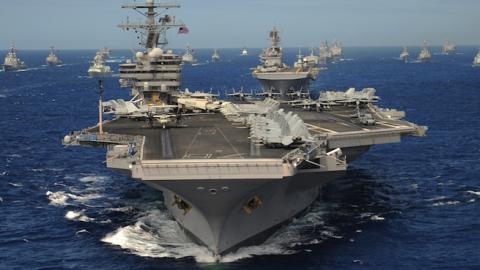At the end of February President Trump said that his Administration will ask Congress for a $54 billion addition to defense spending for the budget year that begins in October. A significant portion would go to the Navy, whose fleet the President has pledged to increase from its current level of 274 combat ships to 350. If a strategy regarding the changing threat to U.S. maritime interests guides President Trump’s naval buildup, the new Administration will make a major contribution to the nation’s security. If the Navy merely builds more ships, an opportunity will be squandered.
Since the Cold War ended, the Navy’s strategic emphasis has been on projecting naval power from the sea to the shore. But times have changed. Overcoming ground-based command-and-control targets (as in Saddam Hussein’s Baghdad) or coastal air defenses (as in Muammar Qaddafi’s Libya) has become less important than another traditional naval task, commanding the seas. Today and in the future, the U.S. Navy will need to concern itself more with the capabilities of competing navies than with relatively vulnerable shore targets.
If a crisis at sea were to turn deadly, Tomahawk missile strikes against a nuclear-armed Beijing or Moscow would invite attacks against the U.S. homeland. It would be better to augment our current advantage in naval forces so that the U.S. Navy could defeat an enemy at sea. But the idea that U.S. sea power should shift its focus to command of the seas has yet to be articulated in a maritime strategy that would secure the nation’s interests via rebuilding U.S. naval power. Such a maritime strategy would go a long distance in stating the case for the Trump naval buildup.
During the quarter-century since the Soviet Union collapsed, the world’s strategic landscape changed dramatically. Failed states, the shards of the Soviet Empire remaining in the Balkans, Middle Eastern chaos, and Islamist terrorism absorbed U.S. attention. In the global war on terrorism, U.S. diplomacy built “coalitions of the willing” while U.S. sea power approached its far-flung targets largely unchallenged by opposing forces and launched strikes at will.
Today’s Russia lacks the global span of its predecessor, the Soviet Union. But the Russian military is fielding impressive new weapons and has returned to patrolling at great distance from the motherland, threatening Europe’s northern and southeastern flanks. Vladimir Putin has grown skillful at using disinformation, cyberattacks, diplomacy, soldiers in uniforms without insignia, and just enough force to achieve his objectives. He has been successful in areas of the Black Sea and Eastern Mediterranean, where Russia is now the chief external power and has the Suez Canal’s northern gateway within easy reach. Putin aspires to dismember NATO, the European Union, and the U.S.-led international order.
Iran has become sufficiently emboldened to provoke U.S. naval vessels in the Persian Gulf’s international waters—as it has three times since January 2016. Its aid to terrorists provides the mullahs with strategic influence from Syria to Yemen. Iran has benefitted enormously from the recent lifting of sanctions, and the funds now available to it can help expand Tehran’s naval reach from the Strait of Hormuz to, and beyond, Bab al-Mandeb, the southern end of the passage that links the Mediterranean to the Indian Ocean.
China’s navy now extends far beyond the international waters of the South and East China Seas, where it claims varying levels of sovereignty. With its aircraft carrier program in full swing, Beijing will eventually be able to bid for control of the straits that connect East Asia with the Middle East. Its military influence in the large gaps in the first island chain is growing. This increases the threat to communications between the United States and its allies in East Asia. The 100 percent support that President Trump recently promised to Japanese Prime Minister Shinzo Abe depends on the U.S. ability to communicate effectively by sea with Japan.
A nation cannot survive as a great power without the ability to use the world’s oceans freely. British dominance of the Channel, Gibraltar, and the Eastern Mediterranean passageway to India choked France during the Napoleonic Wars. Not a single soldier in the armies of Germany’s enemies stood on its soil when World War I ended; the allies’ control of the North Sea and English Channel helped starve Germany into submission. When Nasser nationalized the Suez Canal in 1956 and the Suez War effectively closed it, British officials had to turn to the United States for oil, which contributed to Britain’s defeat. This reaffirmed Britain’s loss of great-power status.
U.S. freedom of global movement, once uncontested, has become a question mark. New anti-access/area denial weapons can be used against the U.S. Navy even by enemies that are not great powers or peer competitors. Russia and China have developed anti-ship missiles, radars, and other military hardware easily transferred to lesser proxies. Yemen’s Houthi rebels, supported by Iran, launched what they said were Chinese-made missiles against a U.S. guided-missile destroyer off Yemen’s south coast in October 2016. Threats to the world’s chokepoints are growing. Unless deterred or checked, challenges at sea, from large powers as well as very small ones, will increase.
The most distinguished strategic thinkers of the late 19th and early 20th century can be divided into camps on the question of sea power. The British geographer and MP Halford Mackinder argued that control of the “world island,” i.e. the connected landmasses of Europe and Asia, gave its possessor command of the world.
More than a decade before Mackinder, U.S. Admiral Alfred Thayer Mahan looked at European history since the 17th century and concluded that decisive command of the seas was key to great-power status. However, the conflicting ideas of Mahan and Mackinder do not absolutely exclude one another. U.S. policy sought and still seeks to prevent a hegemon from dominating the Eurasian landmass. But sea power remains an essential element in U.S. policy, as our World War II and Cold War efforts to keep Atlantic supply lines open and today’s focus on the South and East China Seas shows. The prospect of a single power controlling the expanse of land between Shanghai and Calais is remote. So long as this is so, sea power will be critical to international commerce, power projection, and the deterrence of war or victory therein.
President Trump seeks to strengthen the Navy—increasing its current fleet of 274 combat vessels to 350. But how his priority of fighting terrorism justifies such a buildup is unclear. The threats from ISIS and other terror groups are serious. That U.S. sea power is over-stretched, insufficiently ready, and badly under-equipped is deeply troubling. These problems beg for swift resolution. But they do not comprise a rationale for a significantly larger U.S. Navy.
The over-arching reason for ensuring the dominance of U.S. sea power is to preserve the liberal international order that has benefitted the world and the United States since the end of World War II. In this order, freedom of navigation supports free trade and free markets; the U.S. backstops our allies’ security (thus protecting us by keeping threats at a distance); and the sphere of democratic nations is both safeguarded and enlarged. Although President Trump appears to question some of these objectives, they cannot be separated from the justification for superior U.S. sea power. Defeating terror is no reason to build a fleet that is over one-fourth larger than today’s.
So long as the United States sees supporting today’s international order as its interest, the strategic argument for revitalizing U.S. sea power is the growing danger that peer and near-peer competitors pose to the U.S. ability to conduct international trade freely, to communicate safely with its allies, and to swing its armed forces from one part of the world to another. Russia, China, and Iran sit coincidentally and unfortunately upon, or near, the global chokepoints that affect everything borne by sea, from oil and grain to naval vessels.
This past year, Congress asked the Navy and two research institutes to offer ideas about how the U.S. combat fleet should be designed and configured. These studies have recently been completed. They do not—nor were they intended to—offer a strategic justification for their recommendations, which include the enlargement of the fleet. However, the justification is more than clear. Serious competitors keep emerging and with them the increasing possibility of conflict. Their growing ability to command or at least deny the world’s key oceanic passages to the United States is sufficient reason to rebuild U.S. sea services and provide the nation with a clear maritime strategy.
















